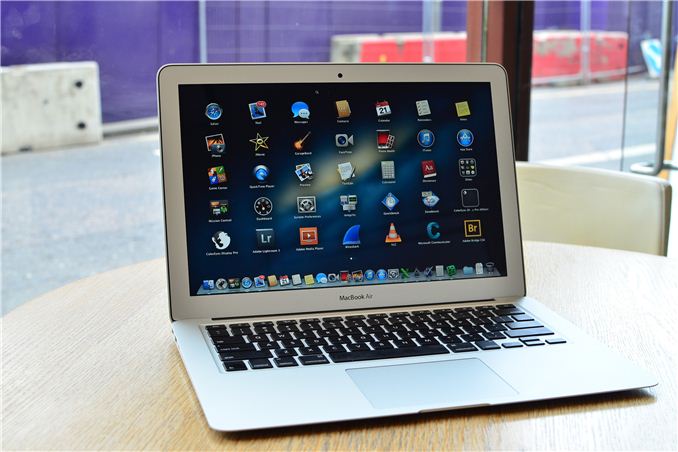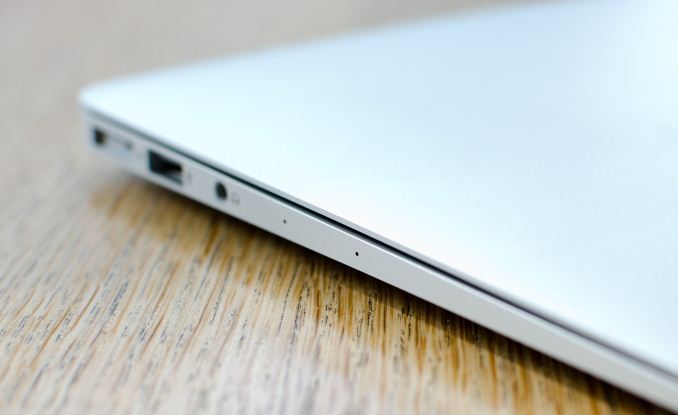The 2013 MacBook Air Review (13-inch)
by Anand Lal Shimpi on June 24, 2013 12:01 AM EST
Things didn’t go exactly as I’d expected at WWDC. I spent the week before the show at Computex, talking to PC OEMs, who had all just launched their Haswell ULT based Ultrabooks. With a couple of exceptions however, the bulk of Haswell ULT systems weren’t scheduled to ship until later this year. Even the Acer S7 I snagged while in Taipei was still a pre-production unit, with final hardware due out in the next month. Based on what I saw in Taiwan, and Intel having seeded me an Iris Pro machine the week before, I assumed that the MacBook Pro with Retina Display is what would get the Haswell treatment first. Obviously, that didn’t happen.
In hindsight, the move makes sense. Apple will sell far more MacBook Airs than rMBPs. The Apple/Intel relationship is looking very healthy these days, so it’s also not surprising that it would have supply and early enough access to Haswell ULT to launch the MBAs at WWDC with almost immediate availability. The Haswell ULT shift didn’t require a new chassis for Apple, which meant a less complex development process.
From the outside, the new MacBook Air looks nearly identical to its predecessor. There's a second mic opening on the left side of the machine now, but otherwise you'd be hard pressed to tell this year's model apart from the previous generation. Internally, nearly everything has changed.
The battery is higher capacity, with no increase in weight. Making better use of that larger battery is Intel's new Haswell ULT silicon. Since we're talking about a ULT part, the PCH moves from the motherboard to the CPU package - creating an emptier motherboard than we've seen in previous years:
The 2013 13-inch MacBook Air Motherboard, Courtesy iFixit
It's clear to me that the MBA is due for a more significant redesign, but this is not the year for that.
Alongside Haswell comes a brand new PCIe SSD, 802.11ac support and LPDDR3 memory. All at a price equal to, if not less than last year's models:
| 2013 MacBook Air Lineup | ||||||
| 11.6-inch | 11.6-inch (high-end) | 13.3-inch | 13.3-inch (high-end) | |||
| Dimensions |
H: 0.11-0.68" (0.3-1.7cm)
W: 11.8" (30cm) D: 7.56" (19.2cm) |
H: 0.11-0.68" (0.3-1.7cm)
W: 12.8" (32.5cm) D: 8.94" (22.7cm) |
||||
| Weight | 2.38 lbs (1.08kg) | 2.96 lbs (1.35kg) | ||||
| CPU | 1.3GHz dual-core Core i5 | 1.3GHz dual-core Core i5 | ||||
| GPU | Intel HD 5000 | |||||
| RAM | 4GB LPDDR3-1600 | |||||
| SSD | 128GB PCIe SSD | 256GB PCIe SSD | 128GB PCIe SSD | 256GB PCIe SSD | ||
| Display Resolution | 1366 x 768 | 1440 x 900 | ||||
| Ports | Thunderbolt, 2x USB 3.0, headphone jack | Thunderbolt, 2x USB 3.0, SD card slot, headphone jack | ||||
| Networking | 2x2:2 802.11ac | 2x2:2 802.11ac | ||||
| Battery | 38 Wh | 54 Wh | ||||
| Price | $999 | $1199 | $1099 | $1299 | ||
We've been over the MacBook Air chassis thoroughly in the past so I won't go through it again here. Build quality remains excellent. The clickpad and backlit keyboard never give me any troubles either. It's sad that we're still having clickpad issues elsewhere in ultraportables but this is one area where Apple's vertically integrated advantage is apparent (as is the company's willingness to spend a little extra on even the little details).
The only thing that hasn't changed, that perhaps should have is the display. The MacBook Air retains the same 1366 x 768/1440 x 900 panels from last year, while much of the competition has moved to at least 1080p IPS in the 13.3-inch form factor. This year at Computex we saw a number of systems move to 2560 x 1440 13.3-inch panels, at least as an option, however I'm expecting those systems to be priced more in line with the 13-inch rMBP rather than the MacBook Air. Admittedly, I don't know the right solution here.Ultra high resolution panels drive cost and power consumption up, the latter which can be offset by going to a larger battery - but then you have a 13-inch rMBP. Perhaps the right move for the MacBook Air would be for Apple to move to IPS panels at least? Or maybe we see a merger of the 13-inch MBA/rMBP, and something new entirely replace the 11-inch model.












233 Comments
View All Comments
spronkey - Monday, June 24, 2013 - link
Hmm. Very interested to see the CPU and battery life numbers for the i7 upgrade. If it manages to increase performance by 10% or so, and decrease battery life 10% or so, it could be a nice sweet spot.Bkord123 - Tuesday, June 25, 2013 - link
I can't wait for the i7 review. I think it's the once I'm leaning toward getting.timmyj9 - Monday, June 24, 2013 - link
i would be curious to know if the same 802.11ac file sharing bottlenecks occur when using NFS as the file sharing protocol?Kevin G - Monday, June 24, 2013 - link
It would as the tweak to resolve it was made to TCP and modern NFS are built on top of that.Khato - Monday, June 24, 2013 - link
Can't agree more that Haswell battery life is already blurring the lines with current tablets. I'm curious how the 2013 Tablet Bench Web Browsing suite compares specifically to the one used on notebooks? In the details provided in this review the specific frequency of web page loading is specified while it's not in the Tablet version.The iPad 4 with it's 42.5Wh battery and 9.48 hours of run-time in the test draws an average of 4.48W. If that test is comparable to the Light version shown here then you have the Haswell Macbook Air drawing an average of 4.9W, while if it's comparable to the Medium version then the average is 6.05W. Either way, when you consider that the Macbook Air's 13.3" diagonal screen has 1.88x more surface area than the iPad 4 (nit is another term for cd/m^2, so total luminous intensity of a 13.3" screen at 200 nits is 1.88x that of a 9.7" screen at 200 nits) it's pretty much a given that display power for the Macbook Air is higher than for the iPad 4 despite the lower resolution. Pretty cool.
Shivansps - Monday, June 24, 2013 - link
The HD5000 is running on single channel right? there is a 2do slot for another memory?Kevin G - Monday, June 24, 2013 - link
The entire SoC has dual channel memory. The MacBook Air has no memory expansion slots. If you want to get one of these, be sure to order with the amount of memory you think you'd need in the future.Shivansps - Monday, June 24, 2013 - link
Im saying that because of the IGP performance, i cant find any confirmation on the review that the MBA is running on dual channel memory, 4GB LPDDR3 sounds like 64 bit single channel to me, and that will impact IGP performance, even HD3000 has reduced 3D performance if not running on dual channel.Glindon - Monday, June 24, 2013 - link
Every Macbook Air that I've owned ran in dual channel mode. Why would this year's be any different.Kevin G - Monday, June 24, 2013 - link
Note the part in this article referring to the LPDDR3. It indicates that it has four 32 bit LPDDR3 packages which indicate a 128 bit wide bus (dual channel).